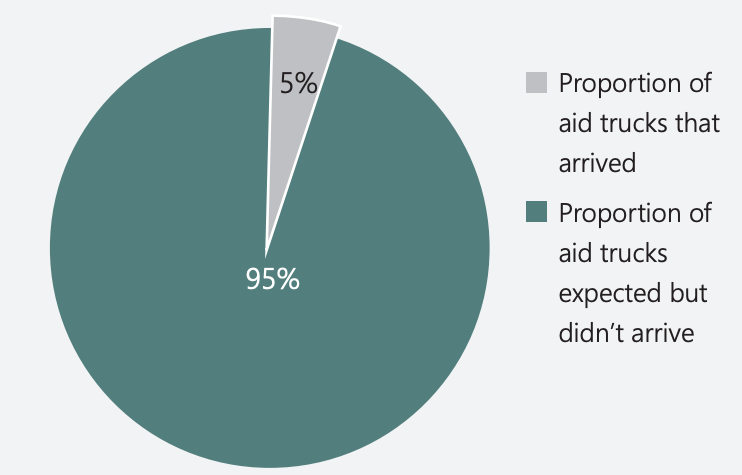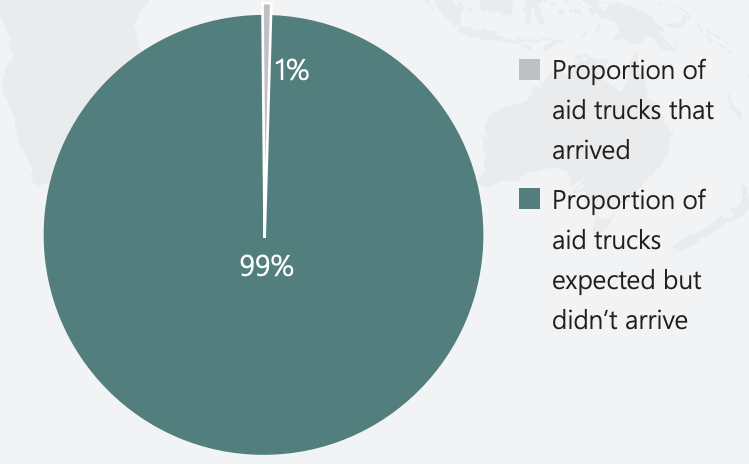Statement
BRINGING TIGRAY CLOSER TO THE WORLD, Tigray Government
Published
3 years agoon
By
Tghat1 OVERVIEW OF THE HUMANITARIAN SITUATION
1.1. Insufficient Humanitarian Supplies and Worsening Humanitarian Crisis
The total blockade of Tigray has resulted in a calamitous humanitarian crisis, putting millions of Tigrayans at risk of death by starvation and easily preventable diseases. In fact, the UN’s relief chief, Martin Griffiths, had highlighted the deleterious impact of the “de facto blockade” of Tigray on humanitarian operations months ago. While limited aid—far from sufficient to meet burgeoning needs—had been trickling into Tigray from July through mid-December, no humanitarian aid was delivered from mid-December through the end of March overland, when the Abiy regime announced a “humanitarian truce,” ostensibly to facilitate humanitarian aid to Tigray.
According to aid agencies, at least 100 truckloads of supplies are needed daily to meet humanitarian needs on the ground. Based on this conservative estimate, from July 12 to April 20, about 28,400 truckloads of supplies should have arrived in Tigray. In reality, only 1420 trucks arrived, representing a mere 5 percent of the required aid (see figure 1).

2 AID DELIVERY FOLLOWING THE “HUMANITARIAN TRUCE”
Since December 15 through the end of March, no humanitarian aid was delivered into Tigray via the only land route (Semera-Abala-Mekelle). On March 24, the Abiy regime declared what it called a “humanitarian truce to, inter alia, facilitate aid flow into Tigray—a move that the Government of Tigray reciprocated. However, as of March 31st, no humanitarian assistance was delivered to the people of Tigray. Since then, 81 truckloads of supplies have been delivered, representing a mere 4 percent of the total aid required during the delivery period.
To put it in broader context, from December 15 through April 20, about 12,700 trucks should have arrived in Tigray. In reality, only 86 trucks were allowed into Tigray, representing a mere 1 percent of the required aid (see figure 2).

2.1 Broad Reflections on the “Humanitarian Truce”
i. Security or lack thereof as an excuse for humani tarian aid blockage.
The Abiy regime and its local intermediaries have routinely provided spurious explanations for their deliberate denial of humanitarian access to Tigray. In that regard, even the limited aid delivery thus far has been critical in dispelling bogus claims about the role of insecurity in hampering humanitarian aid provision. While the claim has always been without any merits, the safe arrival of a limited number of trucks has established that the roads are safe for humanitarian aid delivery into Tigray. This, in turn, has robbed the regime and its allies of their favorite go-to line to rationalize their persistent obstruction of humanitarian aid delivery into Tigray. But absent political will on the part of the international community and some of the powerful actors in the international system, the Abiy regime will continue to come up with specious arguments to justify its inhumane policy.
ii. The Consistent use of access to food as a weapon of war.
We had hoped that the so-called humanitarian truce along with the limited aid delivered recently would be the beginning of sustained humanitarian aid provision. However, old habits die hard. The Abiy regime has not fundamentally altered its deliberate foot-dragging in the face of a staggering humanitarian calamity in Tigray. It is clear that the Abiy regime is dangling the prospect of facilitating the delivery of humanitarian aid into Tigray to stave off international pressure and weaken or kill the momentum of the campaign to hold it accountable for siege-starving its own citizens. In practice, the regime and its local allies have not abandoned their use of starvation and civilian suffering as a tool of war—a war crime under international law as well as a moral obscenity that no human being should endure or countenance.
We had hoped that the so-called humanitarian truce along with the limited aid delivered recently would be the beginning of sustained humanitarian aid provision. However, old habits die hard. The Abiy regime has not fundamentally altered its deliberate foot-dragging in the face of a staggering humanitarian calamity in Tigray. It is clear that the Abiy regime is dangling the prospect of facilitating the delivery of humanitarian aid into Tigray to stave off international pressure and weaken or kill the momentum of the campaign to hold it accountable for siege-starving its own citizens. In practice, the regime and its local allies community has chosen to praise the regime despite allowing only 4 percent of the aid needed into Tigray. Thus emboldened, the Abiy regime continues to make empty promises it has no intention of fulfilling. By reflexively taking seriously the Abiy regime’s empty rhetoric, and refusing to hold it accountable for engineering a colossal humanitarian tragedy, the international community has effectively become complicit in the suffering of millions of people.
iii. The international community has continually failed the people of Tigray.
The international community and some prominent world powers have by and large failed to press the Abiy regime to follow up on its promise of facilitating unfettered humanitarian access to Tigray. Instead of putting sufficient pressure on the Abiy regime to capitalize on this limited window of opportunity and facilitate the delivery of sustained aid consistent with the enormity of needs on the ground, the international community has chosen to praise the regime despite allowing only 4 percent of the aid needed into Tigray. Thus emboldened, the Abiy regime continues to make empty promises it has no intention of fulfilling. By reflexively taking seriously the Abiy regime’s empty rhetoric, and refusing to hold it accountable for engineering a colossal humanitarian tragedy, the international community has effectively become complicit in the suffering of millions of people
iv. The Cessation of hostilities is not an open-ended commitment.
The principal rationale behind the cessation of hostilities agreement is the facilitation of humanitarian aid to Tigray. Absent significant progress on that score, the already untenable situation on the ground will become even more so, fatally undermining the agreement. The Government of Tigray urges the international community to stave off this eventuality by pressuring the Abiy regime to alter course and allow unfettered humanitarian access to Tigray.
3 THE PATH FORWARD
The international community must hurry before millions of Tigrayans perish from hunger and easily preventable diseases. Tigray’s multifaceted humanitarian tragedy can only be resolved only if a number of interlocking measures are undertaken:
- Unfettered humanitarian access. Aside from the fact that no significant aid has been allowed into Tigray since the regime’s announcement of the so-called humanitarian truce, the principal issue regarding aid provision is not about whether some trucks made it to Tigray on a given day. Rather, the issue should be about the presence of a system to facilitate regular, timely, sufficient and unfettered aid flow into Tigray. The regime, rather than fulfilling its legal and moral obligations, routinely presents sporadic episodes of limited aid delivery as an act of charity worthy of commendation. international community must, at last, go beyond the usual statements of concern and take concrete actions to compel the Abiy regime to fulfil its legal obligations under international law
- Lift the deadly blockade of Tigray and restore essential services. The Abiy regime has imposed a watertight blockade on Tigray since the end of June 2021. The resulting humanitarian catastrophe has led to thousands of people dying of hunger and easily preventable diseases. Exacerbating this colossal humanitarian crisis is the suspension of essential social and economic services. Total electricity and telecommunications blackout; the shortage of basic commodities; and the suspension of banking and transportation services have wreaked havoc on Tigray. The suspension of banking services is particularly harrowing, as millions of Tigrayans have not been able to access their hard-earned savings, exposing them to extreme hardship. Furthermore, Tigrayans in the diaspora cannot send remittances to their relatives in Tigray, or to any Tigrayan in need in general.
- Immediate withdrawal of invading Amhara forces from Western Tigray. The invading forces continue to occupy large swaths of Tigray. Amhara expansionist forces have illegally annexed the entire Western Tigray, with all the horrors that it entails. As extensively documented in the joint Amnesty International-Human Rights Watch report, Amhara forces in Western Tigray, with the support of the Ethiopian and Eritrean armies, have engaged in ethnic cleansing of Tigrayans in the hope of bolstering their baseless irredentist claim on a constitutionally recognized Tigrayan territory. Several hundred thousand Tigrayans have been forced out of their homes, compounding the already acute humanitarian emergency in other parts of Tigray. Of those who remain, thousands have been imprisoned and continue to be held under cruel, inhumane and degrading conditions. Furthermore, thousands have been murdered and their mutilated bodies thrown into the Tekeze river, with their remains ultimately floating offshore in the Sudan. The international community must insist on the restoration of the prewar territorial status quo ante. Only then can we begin to address the staggering humanitarian crisis.
- Hold Eritrea accountable for Tigray’s multifaceted crisis and immediately withdraw from territories of Tigray
Although chief responsibility for the suffering of the people of Tigray should be laid at the feet of the Abiy regime and its local intermediaries, the genocidal Isaias regime has also played no less a role in the obstruction of humanitarian aid delivery into Tigray. Although some positive signals have come from the Abiy regime vis-à-vis the provision of humanitarian aid to Tigray, those signals are more than offset by the destructive role of the Isaias regime. The Eritrea regime is continuing its atrocities in western, north western, Central and Estern Tigray with impunity.
Determined to prosecute its genocidal war to its logical conclusion—the extermination of the Tigrayan people—the invading Isaias regime has cultivated parallel links with expansionist Amhara forces and the authorities in Afar. Having cultivated pliant subnational groups within Ethiopia dependent on Eritrean military support and, thus, willing to bend to his will, the authoritarian Isaias leverages these relationships to obstruct humanitarian operations, as it continues to use hunger and the suffering of civilians as a tool of war.
Absent a well-considered strategy to marginalize this spoiler—an entity to whom peace is a threat to its survival or power and is, thus, willing to use force and other malign means to impede efforts to bring it about—the quest for peace in Ethiopia will be elusive.
